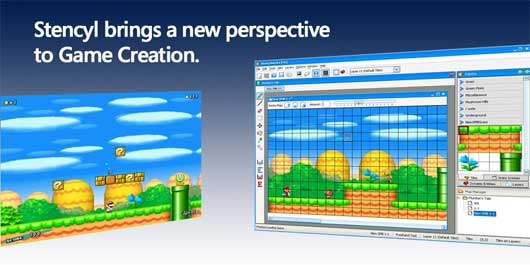

One of the more bizarre things I’ve seen trotted out in Stencyl vs Gamemaker debates is that you can’t code in Stencyl. People thought you couldn’t make decent stuff in GM:S until people started doing it. The strengths of the program are very much a case of “the proof is in the pudding”. Rogue-likes (where the game environment is generated in-game rather than authored) are do-able, and having planets you can only visit once was both a nod to rogue-like conventions and also a response to limitations in the system. Unlike RPG Maker, Stencyl has no built-in functionality for remembering what the player did last time they were in the current room. This is the sort of game where Stencyl’s built in box2d physics system really comes into its own. The player’s ship controls in a “floaty” way similar to the older Lander and Thrust games and has an elemental damage system lifted straight out of Borderlands. Stencyl is still essentially “cheating”, allowing me to make my game-like-objects without having to learn to program.īelow there’s a short video of something I started making back before I was confident in my own art assets – probably my most accomplished Stencyl project. The planet is procedurally generated from a solid wall of tiles plus a script which digs out various winding caves and tunnels and places ores at different depths.
Stencyl studio crack upgrade#
It can make iOS or Android or native PC games (with a reasonable additional upgrade fee for these formats). Whereas Scratch games were (last time I checked) only playable in Scratch, Stencyl can export to Flash and various other file formats. Stencyl is ostensibly a “grown up” version of Scratch. It’s cheating, and its severely limiting, but it’s a nifty shortcut to get to grips with the basics.Ībout 18 months ago I started playing around with Stencyl. Scratch was particularly easy to pick up because the “coding” involved simply involves clicking together blocks of logic into a sort of flow-chart structure. I would spend hours make environments in HalfLife’s editor, and bending Warcraft 3’s engine to try and make genres it wasn’t really intended to make – a practice that gave us the MOBA genre and the (re?)birth of tower defence. This rekindled a love of making game-like-things (I won’t called them “games” because none of them ever reached a state of playability) during my teenage years.

Some of them took to it, some of them didn’t.

4 years ago when I was supporting classes in an IT department we started using Scratch to teach basic game-programming stuff to kids aged 11-16.


 0 kommentar(er)
0 kommentar(er)
